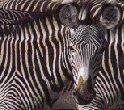.
|
Strength In This Field
Collection:

|
More Info:

|
Where:
 . .
|
|
|
|
|
|
|
|
.
|

Macleay
Museum
Sydney,
Australia
|
 The Macleay Collections house some 1500 mammal
specimens.
The Macleay Collections house some 1500 mammal
specimens.
|

|
.
|
|
.
|

Museums
of Natural
History
Copenhagen
(Faculty of Science, University of Copenhagen)
Denmark
|
 The Mammal
Section holds
collections of some 40,000 specimens - preserved either as
skins + skulls (or whole skeletons), mounted
specimens, or whole specimens or parts in alcohol or
formalin. The particular strengths in these collections are
in:
The Mammal
Section holds
collections of some 40,000 specimens - preserved either as
skins + skulls (or whole skeletons), mounted
specimens, or whole specimens or parts in alcohol or
formalin. The particular strengths in these collections are
in:
- Danish mammals --with
special mention the very large series of Danish bats
(some 3,500 specimens), rodents, harbour porpoises,
badgers, and others;
- Greenland mammals
--terrestrical (with exceptionally large series of polar
bear, reindeer, musk ox, whalrus, narwhal) as well as
marine (most notable famous collection of whale skeletons
with a good taxonomic representation, containing many
specimens from the last century).
.
|

|
.
|
|
.
|

The
Provincial Museum of
Alberta
Edmonton,
Alberta, Canada
|
 The Mammalogy Department has a collection
of some 11,400 catalogue records that includes some 6550
skins, 9800 partial to complete skeletons, 500 taxidermy
mounts, and approximately 80 whole specimens in fluid. The
storage of soft tissues for DNA and other molecular analyses
was initiated recently. The collection focuses on Alberta
and documentation of the distribution of species is more
complete for the southern portion of the province. Although
the collection of Alberta mammals is the primary focus here
making this Museum among the largest and most representative
of Alberta mammals, more recently, the Museum has expanded
its inventory by acquiring non-Alberta species as
well. Mammals are
featured here in the Habitat
Gallery and other
ongoing natural history exhibits.
The Mammalogy Department has a collection
of some 11,400 catalogue records that includes some 6550
skins, 9800 partial to complete skeletons, 500 taxidermy
mounts, and approximately 80 whole specimens in fluid. The
storage of soft tissues for DNA and other molecular analyses
was initiated recently. The collection focuses on Alberta
and documentation of the distribution of species is more
complete for the southern portion of the province. Although
the collection of Alberta mammals is the primary focus here
making this Museum among the largest and most representative
of Alberta mammals, more recently, the Museum has expanded
its inventory by acquiring non-Alberta species as
well. Mammals are
featured here in the Habitat
Gallery and other
ongoing natural history exhibits.
.
|

|
.
|
|
.
|

Museo
di Storia Naturale di Firenze
(Natural History Museum of
Florence)
Florence
Italy
|
 Zoology
- The Specola Museum was opened to the public in 1775, and
it is the oldest scientific museum in Europe. It holds the
largest collection of anatomical waxworks in the world,
manufactured between 1770 and 1850 and over 3,500,000
animals, of which only 5,000 are in view to the
public.
Zoology
- The Specola Museum was opened to the public in 1775, and
it is the oldest scientific museum in Europe. It holds the
largest collection of anatomical waxworks in the world,
manufactured between 1770 and 1850 and over 3,500,000
animals, of which only 5,000 are in view to the
public.
|

|
.
|
|
.
|

The
Natural History Museum and Botanical
Garden
Oslo
Norway
|
 The
Zoological Museum
consists of five (5) main sections:
The
Zoological Museum
consists of five (5) main sections:
- The Introductory Hall
contains exhibits
showing the diversity of life forms, results of animal
migration studies and examples of ecological
adaptation;
- The Norwegian
Hall
shows the animal life
of Norway from the seashore to the highest windswept
peaks where the ptarmigan finds its precarious basis for
existence. Everything is displayed in its natural
habitant. Here, for instance, you can see a beaver dam or
watch the pre-mating antics of a
wood-grouse!
- The Spitsbergen Hall
shows scenes from
arctic animal life;
- The Animal Geography
Hall
you will find animals
from the whole world -from penguins in the frozen
landscape of the South Pole to chimpanzees and okapi in
the rainforest of Africa; and
- The Systematic
Hall where there is a
display of Norways animals, from the single celled
organisms upwards to the largest mammals. You can also
listen to recordings of animal sounds in this
hall.
.
|

|
.
|
|
|

Natural
History Museum
Berne
Switzerland
|
 The Collection of Vertebrate
Animals contain
roughly the material listed below.
The Collection of Vertebrate
Animals contain
roughly the material listed below.
|

|
|
|
|
|
|
|
|
|
|
|
|
|
|

